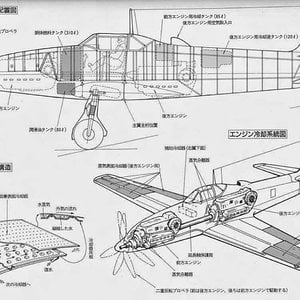Something that has seen surprisingly little discussion even here.
Why was there no successful tandem or push pull twin? The only ones to ever reach production (sorta kinda) I can think of were the VB 10 and Do 335 respectively. Both pretty much pointless by the time they came out, Do 335's job taken over by 262s, and the VB getting sorted out about a year before Mig 15.
Now there's obviously a lot of very good reasons (financial, logistical, etc) to not make a twin engined "pure" fighter. What I'm more interested here is purely technical issues, and what, if anything, could have been done to remedy them.
So, maybe?
Tandems: routing the power from rear engine. Not enough room for driveshaft in the "Vee". Seen numbers like 70mm for the "cannon hole" in DB's. Hissos being the least cramped, and that's what the only serious experiments I know of were made with IIRC (the VB 10 and Bolkhovitinov Sparka). Rear engine needed gearing just to raise the driveline, and if you did the logical thing also having it be the actual reduction gear, you now had torque multiplication to deal with. Pretty much anything with remote drive had the shaft run at engine rpms with gearbox mounted at the prop, the only exception I can think of was Do 335 but that driveshaft was absolutely massive. Then again, Fiat AS6 somehow managed to run not one, but two, concentric, geared down driveshafts through it's front half...
Push pulls: all kinds of trouble with rear engine. Prop striking runway (or bailing pilot), crap getting thrown into prop by landing gear. Some aerodynamic inefficiency (how much? Fokker D23 did pretty well for it's size vs combined power). Central nacelle getting overcrowded in twin boom designs. Possible vibration issues for rear prop right behind the wing, especially when the pilot really hauls back on the stick with combat flaps out?
Cooling issues for both, along with all the serviceability crap that comes along with buried engines?
Maybe not strictly a topic for this thread, but why not a v16-v24 with central power takeoff? Chrysler made one, and it supposedly worked pretty well, just too late. The concept itself was certainly known (Bugatti U16).
Why was there no successful tandem or push pull twin? The only ones to ever reach production (sorta kinda) I can think of were the VB 10 and Do 335 respectively. Both pretty much pointless by the time they came out, Do 335's job taken over by 262s, and the VB getting sorted out about a year before Mig 15.
Now there's obviously a lot of very good reasons (financial, logistical, etc) to not make a twin engined "pure" fighter. What I'm more interested here is purely technical issues, and what, if anything, could have been done to remedy them.
So, maybe?
Tandems: routing the power from rear engine. Not enough room for driveshaft in the "Vee". Seen numbers like 70mm for the "cannon hole" in DB's. Hissos being the least cramped, and that's what the only serious experiments I know of were made with IIRC (the VB 10 and Bolkhovitinov Sparka). Rear engine needed gearing just to raise the driveline, and if you did the logical thing also having it be the actual reduction gear, you now had torque multiplication to deal with. Pretty much anything with remote drive had the shaft run at engine rpms with gearbox mounted at the prop, the only exception I can think of was Do 335 but that driveshaft was absolutely massive. Then again, Fiat AS6 somehow managed to run not one, but two, concentric, geared down driveshafts through it's front half...
Push pulls: all kinds of trouble with rear engine. Prop striking runway (or bailing pilot), crap getting thrown into prop by landing gear. Some aerodynamic inefficiency (how much? Fokker D23 did pretty well for it's size vs combined power). Central nacelle getting overcrowded in twin boom designs. Possible vibration issues for rear prop right behind the wing, especially when the pilot really hauls back on the stick with combat flaps out?
Cooling issues for both, along with all the serviceability crap that comes along with buried engines?
Maybe not strictly a topic for this thread, but why not a v16-v24 with central power takeoff? Chrysler made one, and it supposedly worked pretty well, just too late. The concept itself was certainly known (Bugatti U16).



